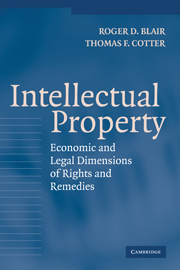Book contents
- Frontmatter
- Contents
- Acknowledgments
- 1 Introduction
- 2 The Law and Economics of IPRs
- 3 A General Theory of Damages Rules
- 4 Departures from the General Theory
- 5 Liability Standards for IPRs
- 6 Who Is an Infringer?
- 7 Who Should Be Entitled to Sue for Infringement?
- 8 Calculating Monetary Damages
- 9 Concluding Remarks
- Bibliography
- Index
3 - A General Theory of Damages Rules
Published online by Cambridge University Press: 08 January 2010
- Frontmatter
- Contents
- Acknowledgments
- 1 Introduction
- 2 The Law and Economics of IPRs
- 3 A General Theory of Damages Rules
- 4 Departures from the General Theory
- 5 Liability Standards for IPRs
- 6 Who Is an Infringer?
- 7 Who Should Be Entitled to Sue for Infringement?
- 8 Calculating Monetary Damages
- 9 Concluding Remarks
- Bibliography
- Index
Summary
As we have seen, the standard justification for patents and copyrights is that they provide a necessary incentive to create, disseminate, and commercialize inventions and works of authorship. They also may serve other functions, such as enabling the rights holder to coordinate investment in follow-up improvements. Trade secret law may supplement patent protection and conserve on some social costs, whereas trademark law reduces consumer search costs and provides an incentive to invest in quality control. A general preference for injunctions as a means for enforcing these rights would tend to preserve these incentive structures, but injunctive relief alone may be incomplete due to time lags, the cost of enforcement, and other real-world problems. Detecting and proving infringement is rarely instantaneous, for example, and thus some time will elapse from the moment the infringement begins until a court can enter an injunction. Damages rules, therefore, may be necessary to preserve the incentive structure, both by deterring infringement and by appropriately compensating the rights holder when infringement does occur. In this chapter, we construct a simple model of optimal damages rules for patent cases. In the following chapter, we compare our simple model with the actual rules that prevail in patent, trade secret, copyright, and trademark law.
THE PATENT INCENTIVE
We begin by presenting a stylized model of a firm's decision to invest in creating and marketing a new invention. At the initial stage, nearly all of the variables that are likely to affect this decision are uncertain.
- Type
- Chapter
- Information
- Intellectual PropertyEconomic and Legal Dimensions of Rights and Remedies, pp. 42 - 69Publisher: Cambridge University PressPrint publication year: 2005
- 2
- Cited by



